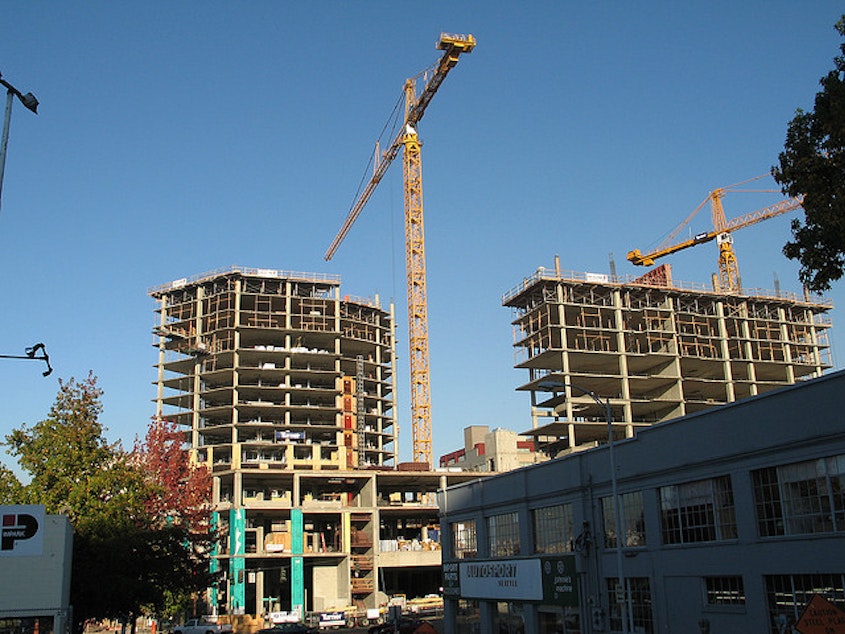Construction Is Everywhere, But Industry Still Fragile

Construction is now the fastest-growing industry in Washington state. Construction cranes fill the skyline. Public works projects like light rail lines and the tunnel project snarl our streets. But despite appearances, construction has not yet fully recovered from the 2008 recession.
Though parts of the industry are growing quickly, none has attained a return to 2008 employment levels. Part of the reason is the depth of the collapse in construction: no sector in Washington state cratered more than construction did during the recession.
During the recession, one in three King County construction jobs disappeared. Compare that to the Seattle metropolitan area, which lost less than 10 percent of its jobs overall. Construction – an indicator of economic confidence – also stayed down longer.
"Construction actually didn’t start to turn around until 2011. So it was hit harder than any industry by a long shot. It was also the longest to begin to recover," said Anneliese Vance Sherman, a regional labor economist with the Employment Security Department. "We are seeing a recovery and we’ve been seeing a consistent and strong recovery in construction. But the losses were exceptionally deep for this sector."
Construction isn’t one big industry. It’s a lot of different specialties; and they’re all recovering at different rates. Jeff Greene, who builds schools and is finishing up a new high school in Shoreline, said work in his specialty is coming back. But the recovery in construction overall is still fragile.
"It’s not very broad-based. It’s very niche and it looks like going forward it’s going to stay niche for a while. And it’s not what you saw between 2000 and 2007 where across all market segments you have a lot of work," said Greene. "Depends on where you are and what you do."
Here’s an example: House painters and carpet layers were among the worst affected. Jeff Kelley is a director at the International Union of Painters and Allied Trades, their union. "We have 18 percent unemployment, which to us looks good now. To the 18 percent it doesn’t look good, but to us when we were looking at 40 percent, 18 is a major improvement."
Kelley said he's optimistic. He thinks things are going to get better as more of the buildings get to the finishing stage. "We’ve been on this glide-path up for the past twelve month and that’s positive. Will we ever be back to the boom it was prior to this recession? I doubt it. Ever. Ever. That was the biggest boom I had ever seen in my life."
Every part of the construction sector was clobbered by the recession. But there was a backbone, and that was public projects. Sound Transit, for example, kept working on the light rail line straight through the recession. That work, in turn, sparked housing development around new light rail stations.
Housing is another example of how the recovery looks different for different parts of the construction industry. Apartment buildings have been going up all over Seattle.
But starts of apartment buildings actually declined this spring. The state’s Economic and Revenue Forecast Council says the number of permits being issued for housing fell more than expected. The decline was in apartment building permits, which fell by more than half – a bigger correction than expected. This may just be temporary; the state’s forecasters expect that segment to pick up again.
Single-family housing construction, meanwhile, seems to be shifting around in the region.
Greene said King County’s built up for now, so the action is switching to other places. "We’re seeing a pick-up in single family residences in Pierce County. I’m sure it’s picking up in Snohomish County, probably slowing down in King County."
These shifts work to some builders’ disadvantage, while helping others. Jim Bickley, a house framer, just received great news. "I just signed a contract in Marysville for 179 houses," he said. "It’s about three years of work."
Bickley said the recession had forced him to take a 40 percent pay cut. He didn’t notice a pick-up in work until less than a year ago. Now that he has three years of stability, he's planning some changes.
"I want to sell my house, downsize, and start enjoying life," he said. "Because it's been so stressful the last five years."
This story is part of The Big Reset, KUOW’s series that explores how the Puget Sound Region has emerged from the Great Recession.
